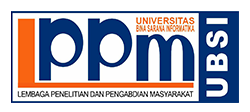Infodemi COVID-19 dengan Peran Social Media Fatigue, Deficient Self-Regulation, dan Promosi Diri
Abstract
Social media envelopes a tremendous impact on the spread of the COVID-19 virus information. Nevertheless, this also increases the probability of misinformation-spreading as well. Using the affordace theory as well as the cognitive load theory, this study aims to analyze the effects of social media fatigue (SMF), deficient self-regulation (DS-R), and self-promotion on the spread of the COVID-19 misinformation on social media. The population of this research includes Indonesian social media users in the age range of 18 to 24 years old, with a number of sample N=155 (retrieved from G*power software). We use the Likert scale for our questionnaire, and the convenience sampling method for our study, spreading the questionnaire through online platforms such as LINE, WhatsApp, and Instagram. The data will then be analyzed using the SPSS software.
Keywords: misinformation, social media, COVID-19
Keywords
Full Text:
PDFReferences
Acharya, A. S., Prakash, A., Saxena, P., & Nigam, A. (2013). Sampling: Why and how of it. Indian Journal of Medical Specialties, 4(2), 330-333.
Chen, X., Wei, S., Davidson, R. M., & Rice, R. F. (2019). How do enterprise social media affordances affect social network ties and job performance? Inf. Technol. People, 33(1), 361-388.
Crano, W. D., Brewer, M. B., & Lac, A. (2015). Principles and Methods of Social Research. New York, NY: Routledge.
Dhir, A., Kaur, P., Chen, S., & Pallesen, S. (2019). Antecedents and consequences of social media fatigue. International Journal of Information Management, 48, 193-202.
Dhir, A., Yossatorn, Y., Kaur, P., & Chen, S. (2018). Online social media fatigue and psychological wellbeing—A study of compulsive use, fear of missing out, fatigue, anxiety and depression. International Journal of Information Management, 40, 141-152.
Faul, F., Erdfelder, E., Lang, A. G., & Buchner, A. (2007). G* Power 3: A flexible statistical power analysis program for the social, behavioral, and biomedical sciences. Behavior research methods, 39(2), 175-191.
George, D., & Mallery, P. (2018). Reliability analysis. In IBM SPSS Statistics 25 Step by Step (pp. 249-260). Routledge.
Ghozali, I. (2013). Metodologi Penelitian. Bandung: Pustaka Setia.
Gibson, J. J. (1966). The Senses Considered As Perceptual Systems. England: Houghton Mifflin, Oxford.
Gupta, L., Gasparyan, A. Y., Misra, D. P., Agarwal, V., Zimba, O., & Yessirkepov, M. (2020). Information and misinformation on COVID-19: a cross-sectional survey study. Journal of Korean medical science, 1-11.
Islam, A. K., Mantymaki, M., & Benbasat, I. (2019). Duality of self-promotion on social networking sites. Inf. Technol. People, 32(2), 269-296.
Islam, A. N., Laato, S., Talukder, S., & Sutinen, E. (2020). Misinformation sharing and social media fatigue during COVID-19: An affordance and cognitive load of perspective. Technological Forecasting and Social Change, 159, 1-14.
Laato, S., Islam, A., Islam, M., & Whelan, E. (2020). What drives unverified information sharing and cyberchondria during the COVID-19 pandemic? Eur. J. Inf. Syst., 1-18.
Liu, H., Liu, W., Yoganathan, V., & Osburg, V. S. (2021). COVID-19 information overload and generation Z's social media discontinuance intention during the pandemic lockdown. Technological Forecasting and Social Change, 166, 1-12.
Moon, J. H., Lee, E., Lee, J. A., Choi, T. R., & Sung, Y. (2016). The role of narcissism in self-promotion on Instagram. Personality and individual Differences, 101, 22-25.
Nemoto, T., & Beglar, D. (2014). Likert-scale questionnaires. In JALT 2013 conference proceedings, (pp. 1-8).
Newman, J. P., & Wallace, J. F. (1993). Diverse pathways to deficient self-regulation: Implications for disinhibitory psychopathology in children. Clinical Psychology Review, 13(8), 699-720.
Nguyen, H., & Nguyen, A. (2020). Covid-19 misinformation and the social (media) amplification of risk: A Vietnamese perspective. Media and Communication, 8(2), 444-447.
Norman, D. A. (1988). The Psychology of Everyday Things. New York: Basic Books.
Norman, D. A. (1988). The Psychology of Everyday Things. New York, NY: Basic Books.
Odeh, R. E. (1982). Critical values of the sample product-moment correlation coefficient in the bivariate normal distribution. Communications in Statistics Simulation and Computation, 11(1), 1-26.
Peters, G. J. (2014). The alpha and the omega of scale reliability and validity: why and how to abandon Cronbach’s alpha and the route towards more comprehensive assessment of scale quality.
Sweller, J. (2011). Cognitive load theory. Psychology of Learning and Motivation, 55, 37-76.
Talwar, S., Dhir, A., Kaur, P., Zafar, N., & Alrasheedy, M. (2019). Why do people share fake news? Associations between the dark side of social media use and fake news sharing behavior. J. Retail. Consum. Serv., 51, 72-82.
Thompson, N., Wang, X., & Daya, P. (2019). Determinants of news sharing behavior on social media. J. Comput. Inf. Syst., 21(5), 512-528.
Travakol, M., & Dennick, R. (2011). Making sense of Cronbach's alpha. Int J Med Educ., 53-55.
Wainer, H., & Braun, H. I. (2013). Test Validity. Routledge.
Whelan, E., Islam, A. N., & Brooks, S. (2020b). Is boredom proneness related to social media overload and fatigue? A stress-strain-outcome approach. Internet Res, 30(3), 869-887.
Whelan, E., Islam, A., & Brooks, S. (2020a). Applying the SOBC paradigm to explain how social media overload affects academic performance. Comput. Educ., 143, 103692.
DOI: https://doi.org/10.31294/jkom.v13i1.11951
| Index by: | ||








|
||
| E-ISSN: 2579-3292 | ||

 https://road.issn.org/sites/all/themes/customroad/img/road-issn.png
https://road.issn.org/sites/all/themes/customroad/img/road-issn.png
|
||
Dipublikasikan oleh LPPM Universitas Bina Sarana InformatikaJl. Kramat Raya No.98, Kwitang, Kec. Senen, Kota Jakarta Pusat, DKI Jakarta 10450
|






